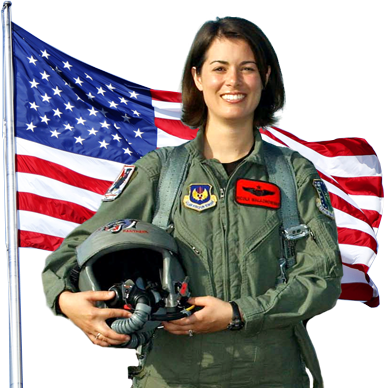- Details
- Hits: 1010
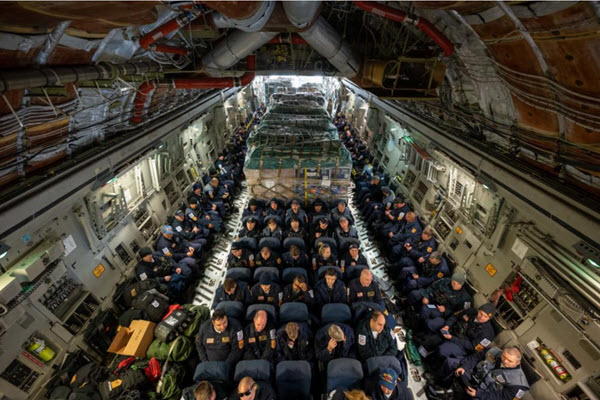
Dover Air Force Base, Delaware. (February 7, 2023): In this photo by Senior Airman Faith Barron, members of the Fairfax County Virginia Urban Search and Rescue Team board a C-7 Globemaster III headed to the earthquake zone as part of the U.S. Agency for International Development (USAID) emergency humanitarian response. The devastating impacts in Türkiye have stretched world resources to their limit as they struggle to cope with the worst earthquake to hit the region in nearly a century.
On February 6, a magnitude 7.8 earthquake struck central southern Türkiye, close to the Syrian border, followed by dozens of violent aftershocks. The earthquakes have resulted in over 45,000 deaths and has displaced millions.
USAID deployed a Disaster Assistance Response Team (DART) to lead the U.S. government’s response efforts to conduct disaster assessments, assist with search and rescue operations, and work with partners on the ground to save lives.
The Urban Search and Rescue team pictured above is a part of the Federal Emergency Management Agency’s urban search and rescue task force based in Fairfax County Virginia and sponsored by the Fairfax County Fire and Rescue Department.
Established in 1986, the task force is composed of over 200 specially trained career and volunteer fire and rescue personnel with expertise in the rescue of victims from collapsed structures following natural disasters or terrorist attacks.
- Details
- Hits: 1192
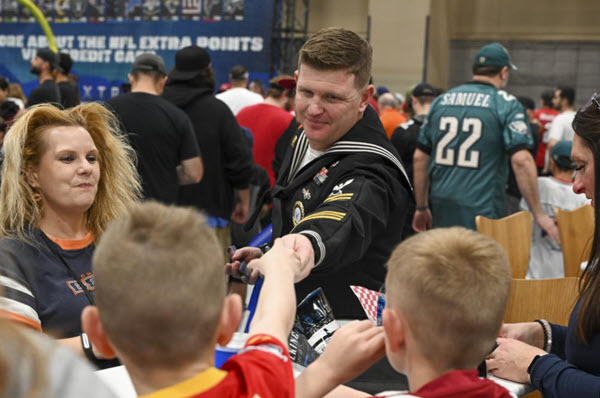
Phoenix, Arizona. (Feb. 5, 2023) – In this photo by Petty Officer 2nd Class Cody Anderson, Damage Controlman 1st Class Kreig Newton hands out recruiting aids to visitors at the Super Bowl 57 Fan Experience. Navy Recruiting Command consists of a command headquarters, two Navy Recruiting Regions, and 26 Navy Talent Acquisition Groups that serve 815 recruiting stations across the world. Their goal is to attract the highest quality candidates to assure the ongoing success of America’s Navy.
Since the Revolutionary War, Navy recruiters have fanned out across the country to recruit potential Sailors and Marines into military service. In 1775, the Navy created the Office of the Secretary of the Navy who assumed direct responsibility for recruiting.
In 1971, in response to the end of the military draft and an increased emphasis on Navy recruiting, the Secretary of the Navy established the Navy Recruiting Command to coordinate outreach to volunteers around the nation. With the ever-increasing technological sophistication Navy ships, submarines, and aircraft, the Navy recruiters must find, inspire, and recruit the best and brightest young men and women to serve in the diverse, high-tech Navy of the 21st Century.
Headquartered in Millington, Tennessee, the Navy Recruiting Command covers the entire United States with twenty-six (26) Navy Recruiting Districts commanded by two Navy Recruiting Regions. Today, nearly 6,000 active, reserve, and civilian contract employees staff more than 1,400 recruiting stations throughout the U.S., Guam, Puerto Rico, and Europe.
- Details
- Hits: 1307
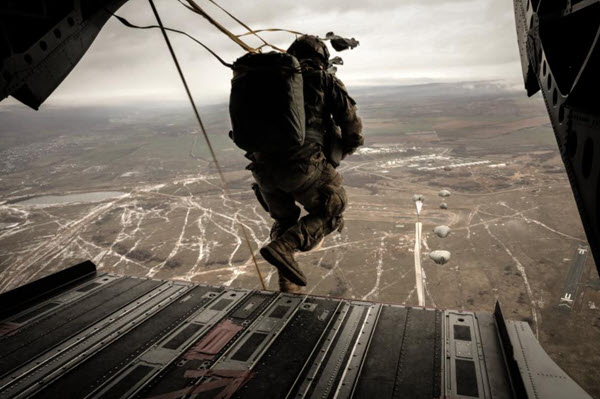
Novo Selo, Bulgaria. (February 4, 2023): In this photo by Pfc. Kyler Hembree, U.S. Army paratroopers assigned to the 54th Brigade Engineer Battalion, 173rd Airborne Brigade leap from a Chinook helicopter during training with America’s ally Bulgaria.
The 173rd Airborne Brigade is the U.S. Army's Contingency Response Force in Europe to provide rapidly deployable forces to the United States European, African, and Central Command areas of responsibility. Forward deployed across Italy and Germany, the brigade routinely trains alongside NATO allies and partners to build partnerships and strengthen the alliance.
The 173rd, nicknamed the “sky soldiers”, is an airborne infantry brigade combat team based in Vicenza, Italy and is responsible for conventional airborne strategic response for Europe. Activated in 1915, the unit saw service in WWII but is best known for its actions in the Vietnam War and the Battle of Dak To. The battle was one of the deadliest encounters with the North Vietnamese Army resulting in heavy casualties. Brigade members received over 7,700 decorations including more than 6,000 purple hearts.
America’s military alignment with Bulgaria dates to 1962 and has played a vital role for NATO ever since. In 2006, the U.S. and Bulgaria signed an agreement to allow a continuous rotation of up to 2500 troops to train with local and neighboring forces on tank warfare, reconnaissance, and how to defend against chemical and biological weapons.
The U.S. government has invested more than $80 million in upgrades and improvements at the Novo Selo site and, given the tensions with Moscow, plans to expand these facilities are likely to continue.
- Details
- Hits: 975

Romania. (January 25, 2023): In this photo by Major Robert Fellingham, U.S. Army air defenders attach their Avenger weapon system to a Chinook helicopter during sling load training near the Black Sea coast of Romania.
Charlie Battery, 5th Battalion, 4th Air Defense Artillery Regiment practiced sling-loading both the Avenger with a Chinook helicopter crew from Bravo Company, Combat Aviation Brigade, 1st Armored Division. Pictured left to right is Specialist Toby Delsignore, Specialist Christopher Salazar, and Specialist Jarod Vanlandingham.
Sling-loading multi-million-dollar equipment to a moving helicopter is challenging and dangerous if not done properly. These soldiers are required to pass a five-day Sling Load Inspector Certification Course (SLICC) to qualify as sling load inspectors. Soldiers must know the special fixtures and accessories used to lift tons of vehicles and equipment, from generators to tanks, while ensuring that the load is evenly distributed and will not fall during transport.
- Details
- Hits: 1758
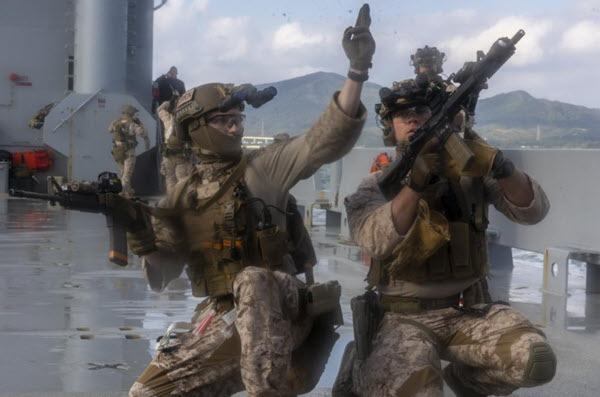
Okinawa, Japan. (January 26, 2023) In this photo by Sergeant Andrew King, U.S. Marines assigned to the Maritime Raid Force, 31st Marine Expeditionary Unit, post security on the USAV Calaboza during a visit, board, search, and seizure (VBSS) training off the coast of Kin, Okinawa.
VBSS training consists of boarding a vessel to systematically check all compartments for enemy personnel, weapons, or contraband. VBSS teams, like the Maritime Raid Force pictured above, are trained to capture enemy vessels, combat terrorism, stop piracy and smuggling, and to conduct customs, safety, and other inspections of suspect vehicles on the open sea.
That is no simple task.
To be a VBSS team member, a Marine must pass three courses on Close Quarter Battle (to develop proficiency in hand-to-hand combat tactics), search procedures, and tactical team movements. Students practice shooting, rappelling, searching, and arrest procedures for non-compliant combatants.
While all Sailors in the U.S. Navy are eligible to serve aboard a VBSS team, only those approved by their ship's command are considered. Being approved does not guarantee inclusion on a VBSS team, as it is possible (and not uncommon) for candidates to wash out of VBSS school which has an attrition rate of up to 30 percent.
U.S. Navy VBSS teams are generally armed with M4 carbines, Mossberg 500 shotguns, and Beretta M9 pistols. They wear Kevlar body armor and a buoyant tactical vest that doubles as a life preserver. The majority of U.S. naval ships deploying with VBSS teams are smaller, such as destroyers or cruisers, who are the most effective to combat illegal narcotics, arms trafficking, and piracy.
These law enforcement activities maintain security and freedom of sea lanes worldwide.
- Details
- Hits: 1570
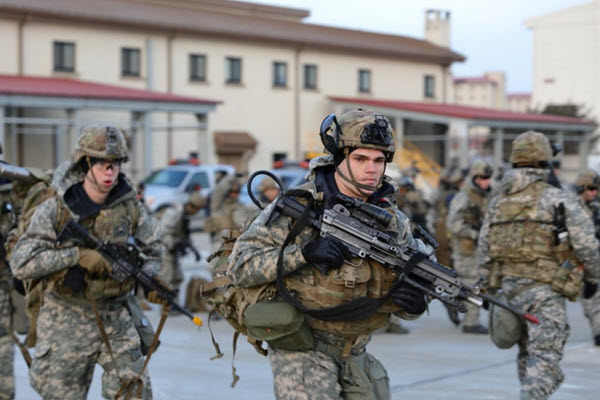
Camp Humphreys, South Korea. (February 2, 2023): In this photo by Captain Frank Spratt, Army Specialist Tyler John Vandkirk of C Company, 2nd Battalion, 1st Infantry Regiment, 2nd Stryker Brigade Combat Team, 2nd Infantry Division begins moving toward a UH-60M Blackhawk helicopter from C Company, 2nd Battalion, 2nd Aviation Regiment on the runway of Desiderio Airfield, Camp Humphreys, South Korea.
A total of 130 Soldiers were transported in UH-60M Blackhawk and CH-47F Chinook helicopters to practice air insertion techniques and link up procedures as part of a combined arms team.
The 2nd Infantry Division, known for its distinctive Indianhead shoulder patch, has the primary mission of pre-emptively defending South Korea in the event of an invasion. There are approximately 17,000 soldiers in the 2nd Infantry Division, with 10,000 of them stationed in South Korea, which accounts for about 35% of the United States Forces in Korea.


